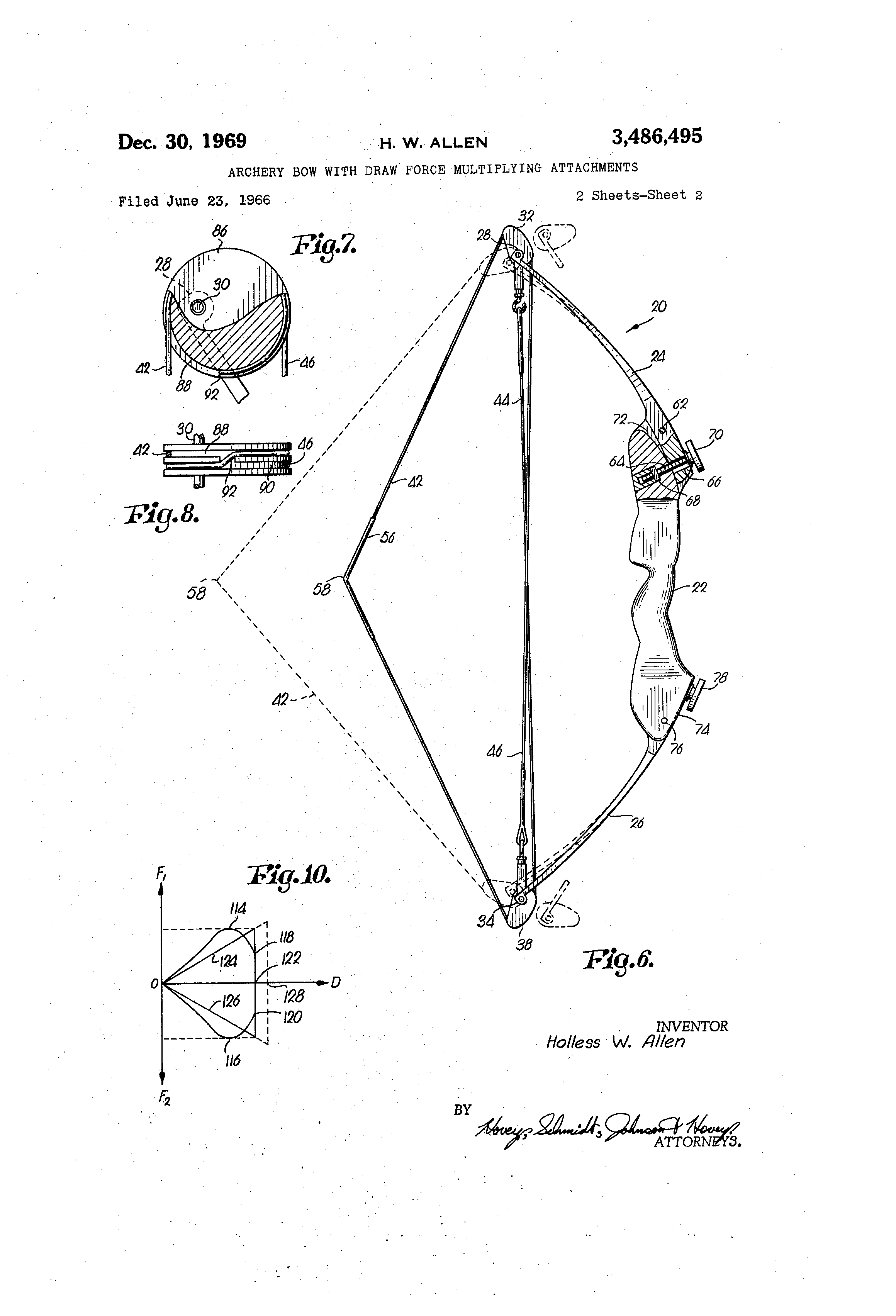Featured image: archeryhistory.com/illustration: Grand View Outdoors
Digging around the garage last winter I found an old friend I hadn’t spoken to in a while. That friend is my first compound bow — a Bear Archery Alaskan 6-wheel model introduced in 1977. I got mine in 1978, a dumb wannabe bowhunter a year out of grad school with no money and big dreams. It featured dual-needle bearings, “micro click” adjustment and the “hot” C4 eccentric wheels that are all of about 1¾ inches in diameter. Needless to say, I didn’t kill much — but I swallowed the bowhunting bug hook, line and sinker.
It’s all thanks to an obscure Missouri innovator named Holless Wilbur Allen.
In the early 1960s, Allen was fiddling with the first compound bow, hoping to give the bows of the future a mechanical advantage over traditional bows. At first, Allen tried sawing the ends off the limbs of a recurve bow and attaching pulleys, which created a crude block-and-tackle system. This system didn't work well, however, as the bow then had a limited draw length due to the short limb-tip travel. After four years of tinkering and who knows how many design changes, Allen settled on a system of cams and eccentric wheels in place of the original pulley system. Allen filed for a patent in June 1966, and in December 1969 patent No. 3,486,495 was issued. Allen also approached several manufacturers about building and marketing his new bow, but found no one willing to accept the challenge. So, he began marketing the Allen Compound Bow — his "Archery Bow With Force Multiplying Attachments" — in 1967.
“All I was trying to develop was a bow that would get an arrow to a 10- to 25-yard target — a deer — before the target could move,” Allen said.
This first compound bow was not quickly accepted by the industry or the public, and sales were modest. It may have staggered along quietly, then died a slow death. Enter Tom Jennings.
In the late 1960s, Jennings was technical editor for the old Archery World magazine (now our sister publication, Bowhunting World), and Allen had sent Tom an early prototype of his compound bow to play with and report on. Jennings published his review in the magazine's May 1967 issue, giving it high marks. He said things like "reduction in peak draw weight," "more stable than recurves" and "the first really new concept to come into bow design in a thousand years." In addition to his writing, Jennings also made fine recurve bows. He quickly applied for, and was granted, Allen's first license, then began building and marketing his own version of the compound bow. Archery, and bowhunting, would never be the same.
By today’s standards, the first compound bows were heavy, clunky and expensive. However, they generally shot their arrows faster, with a flatter trajectory and more consistent accuracy than any other bows around. Compound bows had another advantage not readily apparent to shooters — being made from separate parts, they could be tinkered with and improved more easily than carefully crafted traditional bows. Also, they could be manufactured on an assembly line, which made them potentially more profitable than traditional bows to aspiring manufacturers.
In 1972, only two companies — Carroll Archery Products and Olympus — were marketing compound bows. By 1974, eight companies were selling them to an expanding market. It was this year that Jennings “revolutionized the revolution” with the introduction of his legendary Model-T, a two-wheel compound with tip-to-tip cable harnessing. In contrast, most early compounds followed Allen's basic design of using either four or six wheels, resulting in an awkward, bulky bow that was hard to keep tuned. The Jennings Model-T was lighter and much easier to tune, making it ideal for the serious bowhunter. Sales shot through the roof.
By the late 1970s, several archery companies, including Precision Shooting Equipment (PSE), Bear Archery, Darton, Martin Archery, Browning, Ben Pearson Archery and Hoyt, were challenging Allen and Jennings for the compound bow market. By 1976 all states except Georgia legalized their use during bowhunting seasons. About this time the Pope & Young Club began accepting entries of animals taken with compounds. In 1977, Archer's Digest listed over 100 different models of compound bows, compared to just 50 different versions of the recurve. It took less than 10 years for the compound bow to become the dominant force in all of archery.
By the time Allen's 17-year patent expired in the mid-1980s, a truckload of bow companies had tried their hand at building and marketing archery's future star, the compound bow. Sadly, Allen died in a 1979 automobile accident, not living long enough to see how his compound bow would change the face of bowhunting forever.
Modern compounds have continued to evolve, both in bow design and accessories like arrow rests (think drop-away), how they’re shot (think release aid and string loop) and the arrows they launch (think small-diameter carbon shafts). We owe it all to a man who loved to hunt and fish and whose love of machines and desire to know how they worked set the stage for the modern bowhunting revolution — Holless Wilbur Allen.
Thank you, sir.







